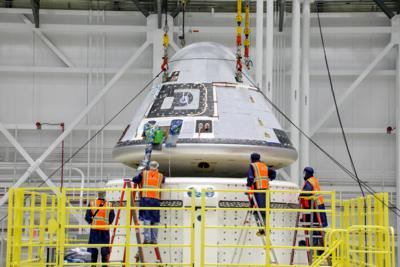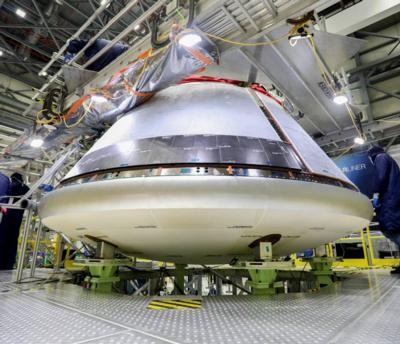Mon, Mar 08, 2021
Winter Storms and Avionics Replacements Take The Blame
NASA and Boeing are evaluating a new target launch date for the CST-100 Starliner’s Orbital Flight Test-2 (OFT-2) to the International Space Station after winter storms in Houston, and the recent replacement of avionics boxes, set the program back about two weeks. NASA also is weighing the volume of verification and validation analysis required prior to the test flight and the visiting vehicle schedule at the International Space Station.

Previously, the launch was targeted for no earlier than April 2.
An important factor the teams are evaluating is the visiting vehicle schedule at the International Space Station, which already has a scheduled crewed Soyuz launch and NASA’s SpaceX Crew-2 mission in April. Based on the current traffic at the space station, NASA does not anticipate that OFT-2 can be accomplished later in April. NASA and Boeing are working to find the earliest possible launch date.
“Boeing and NASA have worked extremely hard to support an early-April launch but we need to assess alternatives to ensure NASA’s safety work can be accomplished. NASA and Boeing know we fly together,” said Kathy Lueders, associate administrator, NASA’s Human Exploration and Operations Mission Directorate. “Boeing has done an incredible amount of work on Starliner to be ready for flight and we’ll provide an update soon on when we expect to launch the OFT-2 mission.”

“I’m grateful for the extraordinary work being undertaken by our NASA partners as we progress towards our OFT-2 mission,” said John Vollmer, vice president and program manager of Boeing’s Commercial Crew Program. “And I’m very proud of the Boeing Starliner team for working so diligently to get the hardware, software and certification closure products ready for flight. We’re committed to demonstrating the safety and quality of our spacecraft and progressing to our crewed test flight and the missions beyond.”
The company has been conducting dry-runs ahead of an end-to-end mission rehearsal that will allow the operations team to practice and observe integrated interactions through the whole mission profile, from launch to docking and undocking to landing. Additionally, power-on testing and checkouts of the OFT-2 vehicle, with new avionics boxes installed, have been completed successfully. Spacecraft fueling operations and the stacking of the launch vehicle are also ready to commence.
More News
From 2017 (YouTube Edition): ADS-B For Airplanes And Drones… ADS-B technology developed by uAvionix has come full circle. The company began with a device developed for manne>[...]
Dead Reckoning Dead reckoning, as applied to flying, is the navigation of an airplane solely by means of computations based on airspeed, course, heading, wind direction, and speed,>[...]
"The next great technological revolution in aviation is here. The United States will lead the way, and doing so will cement America’s status as a global leader in transportat>[...]
Aero Linx: The Mooney Mite Site Dedicated to the Mooney M-18 Mite, "The Most Personal Airplane," and to supporting Mite owners everywhere. The Mooney M-18 Mite is a single-place, l>[...]
Also: Space Command Moves, Alpine Eagle, Duffy Names Amit Kshatriya, Sikorsky-CAL FIRE Collab Textron eAviation is putting the development of its Nexus electric vertical takeoff an>[...]
 Classic Aero-TV: UAvionix - Transitioning Between Manned & Unmanned Technologies
Classic Aero-TV: UAvionix - Transitioning Between Manned & Unmanned Technologies ANN's Daily Aero-Term (09.14.25): Dead Reckoning
ANN's Daily Aero-Term (09.14.25): Dead Reckoning Aero-News: Quote of the Day (09.14.25)
Aero-News: Quote of the Day (09.14.25) ANN's Daily Aero-Linx (09.14.25)
ANN's Daily Aero-Linx (09.14.25) Airborne-NextGen 09.09.25: Textron Nixes ePlane, Joby L/D Flt, Swift Approval
Airborne-NextGen 09.09.25: Textron Nixes ePlane, Joby L/D Flt, Swift Approval




